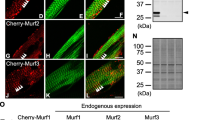Summary
Skeletal muscle regeneration was studied in polymyopathic hamsters of the strain BIO 8262 by autoradiography. Flash labeling with3H-thymidine revealed high labeling indices of mononuclear cells in areas with muscle cell necroses and low labeling of ‘interstitial cells’. However, no labeled nuclei were present in myotubes. Three days after multiple injections of the radioisotope, labeled nuclei in the myotubes were present. The mean labeling intensity of these nuclei was slightly elevated on the 15th day. On the third day after multiple3H-thymidine injections nearly all mononuclear cells were labeled; but their labeling indices slightly decreased until the 15th day. From the decrease of labeling intensity, a high turnover rate of these cells may be assumed.
Labeled myotubes appeared in the neighborhood of mononuclear cells as well as in areas without pronounced round cell infiltrations. From labeled myotubes in areas with round cell infiltrations it may be concluded that they arose by fusion of rapidly proliferating satellite cells, which may be constituents of the mononuclear cell population. Labeled myotubes that appeared outside areas of mononuclear cell infiltrations may have been caused by fusion of slow proliferating satellite cells.
Despite the fact of a high regeneration capacity of muscle in hamsters of the strain BIO 8262, this process is not sufficient to completely restore the muscle necroses.
Zusammenfassung
Mit autoradiographischen Methoden wurde die Skelettmuskelregeneration bei myopathischen Hamstern des Stammes BIO 8262 untersucht. Nach Pulsmarkierung fanden sich hohe Markierungsindices der mononucleären Zellen in Bereichen von Muskelnekrosen und geringe Markierungsindices von “interstitiellen Zellen”. In den neu entstandenen Muskelfasern mit zentralen Kernreihen waren keine markierten Kerne vorhanden. Drei Tage nach multiplen3H-Thymidin-Injektionen waren markierte Kernreihen in Muskelzellen nachweisbar. Die mittlere Markierungsintensität dieser Zellkerne lag am 15. Tag gering höher als am 3. Tage. Die mononucleären Zellen waren am 3. Tag fast alle markiert, am 15. Versuchstag war der Markierungsindex gering abgesunken. Die Markierungsintensität der Infiltratzellen nahm bis zum 15. Tag stark ab, woraus auf eine hohe Umsatzrate dieser Zellen geschlossen werden kann.
Markierte Kernreihen in Muskelzellen kamen sowohl in der Nähe von Infiltraten aus mononucleären Zellen als auch in Bezirken ohne stärkere mononucleäre Zellinfiltrate vor. Von den neu entstandenen Muskelzellen in Bereichen mit mononucleären Zellinfiltraten kann geschlossen werden, daß sie durch Fusion von schnell proliferierenden Satellitenzellen entstanden sind, die als Angehörige der Rundzellpopulation angesehen werden können. Markierte neu entstandene Muskelzellen außerhalb solcher mononukleärer Zellinfiltrate entwickelten sich wahrscheinlich aus langsam proliferierenden Satellitenzellen.
Obwohl die Muskulatur der Hamster des Stammes BIO 8262 eine hohe Regenerationsfähigkeit hat, reicht diese nicht aus, um die Muskeluntergänge zu kompensieren.
Similar content being viewed by others
References
Allbrook, D., de Baker, W. C., Kirkaldy-Willis, W. H.: Muscle regeneration in experimental animals and man. J. Bone Jt Surg.48 B, 153–169 (1966)
Baloh, R., Cancilla, P. A., Kalyanaraman, K., Munsat, T., Pearson, C. M., Rich, R.: Regeneration of human muscle. Lab. Invest.26, 319–328 (1972)
Bintliff, S., Walker, B. E.: Radioautographic study of skeletal muscle regeneration. Amer. J. Anat.106, 233–245 (1960)
Caulfield, J. B.: Electron microscopic observations on the dystrophic hamster muscle. Ann. N.Y. Acad. Sci.138, 151–159 (1966)
Church, J. C. T.: Cell populations in skeletal muscle after regeneration. J. Embryol. exp. Morph.23, 531–537 (1970)
Church, J. C. T., Noronha, R. F. X., Allbrook, D. B.: Satellite cells and skeletal muscle regeneration. Brit. J. Surg.53, 638–642 (1966)
Freund-Mölbert, E., Ketelsen, U.-P.: The regeneration of the striated muscle cell. Beitr. Path.148, 35–54 (1973)
Gilbert, R. K., Hazard, J. B.: Regeneration in human skeletal muscle. J. Path. Bact.89, 503–512 (1965)
Godman, G. Ch.: On the regeneration and redifferentiation of mammalian striated muscle. J. Morph.100, 27–65 (1957)
Hartman, K. S., Standish, S. M.: Muscle regeneration in the dystrophic syrian hamster tongue. Arch. Path.98, 126–133 (1974)
Homburger, F., Nixon, C. W., Eppenberger, M., Baker, J. R.: Hereditary myopathy in the Syrian hamster: studies on pathogenesis. Ann. N.Y. Acad. Sci.138, 14–27 (1966)
Ishikawa, H.: Electron microscopic observations of satellite cells with special reference to the development of mammalian skeletal muscles. Z. Anat. Entwickl.-Gesch.125, 43–63 (1966)
Laird, J. L., Walker, B. E.: Muscle regeneration in normal and dystrophic mice. Arch. Path.77, 64–72 (1964)
Mauro, A.: Satellite cells of skeletal muscle fibres. J. biophys. biochem. Cytol.9, 493–495 (1961)
Mohr, W., Lossnitzer, K.: Morphologische Untersuchungen an Hamstern des Stammes BIO 8262 mit erblicher Myopathie und Cardiomyopathie. Beitr. Path.153, 178–193 (1974)
Moss, F. P., Leblond, C. P.: Nature of dividing nuclei in skeletal muscle of growing rats. J. Cell Biol.44, 459–462 (1970)
Moss, F. P., Leblond, C. P.: Satellite cells as the source of nuclei in muscles of growing rats. Anat. Rec.170, 421–436 (1971)
Reznik, M.: Origin of myoblasts during skeletal muscle regeneration. Lab. Invest.20, 353–363 (1969)
Shafiq, S. A., Gorycki, M. A., Milhorat, A. T.: An electron microscopic study of regeneration and satellite cells in human muscle. Neurology (Minneap.)17, 567–574 (1967)
Shafiq, S. A., Gorycki, M. A., Mauro, A.: Mitosis during postnatal growth in skeletal and cardiac muscle of the rat. J. Anat. (Lond.)103, 135–141 (1968)
Stockdale, F. E., Holtzer, H.: DNA synthesis and myogenesis. Exp. Cell Res.24, 508–520 (1961)
Walker, B. E.: A radioautographic study of muscle regeneration in dystrophic mice. Amer. J. Path.41, 41–53 (1962)
Walker, B. E.: The origin of myoblasts in normal and dystrophic mice. Exp. Cell Res.142, 289 (1962)
Walker, B. E.: Skeletal muscle regeneration in young rats. Amer. J. Anat.133, 369–378 (1972)
Walker, B. E., Drager, G. A.: Evidence of regeneration in repeat biopsies of dystrophic human muscle. Neurology (Minneap.)12, 381–384 (1962)
West, W. T., Murphy, E. D.: Histopathology of hereditary, progressive muscular dystrophy in inbred strain 129 mice. Anat. Rec.137, 279–295 (1960)
Author information
Authors and Affiliations
Rights and permissions
About this article
Cite this article
Mohr, W., Bock, G. & Lossnitzer, K. Skeletal muscle regeneration in myopathic hamsters of strain BIO 8262. Virchows Arch. B Cell Path. 21, 67–77 (1976). https://doi.org/10.1007/BF02899145
Received:
Issue Date:
DOI: https://doi.org/10.1007/BF02899145




